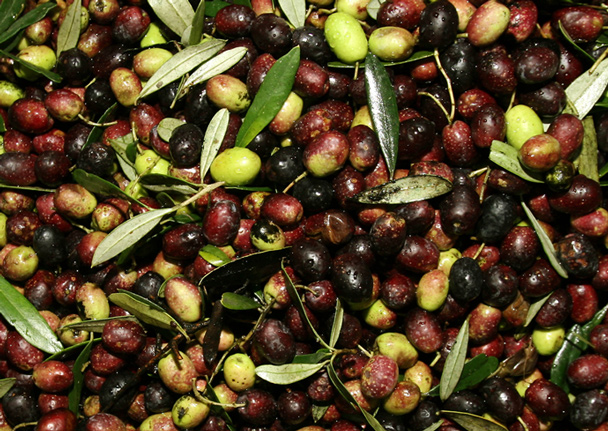If you could fly like a bird over the campagna romana where it fades toward the hills, you would see it clothed in a broad, silvery gray cloak of olive leaves. Those trees are the pride of all Italy's oil production.
For the ancient Italic peoples, the olive tree symbolized not only the fertility of humans and of the earth but also peace and a serene life. Thus, it easy to understand why this plant has traveled the centuries clothed in an aura of sacredness. The oil produced by its fruit was an essential food on poor tables, ever since the time of republican Rome; its oil served to light the lamps, its dregs were a good fertilizer, and its wood, considered precious, could be burned only on the altar of the gods. And the olive tree is indissolubly linked to the advance of Mediterranean civilization.
In the imperial period, the tables of the Roman gourmands made a distinction between the sapid oils of Sabina and the lighter oils of Liguria.¹ The strong, heavy oils from Spain and North Africa were primarily used to fill lamps.
Beginning in the late empire (fourth century A.D.), olive culture declined along with agriculture. The great abbeys, such as Farfa and Subiaco,² had charge, sometimes together, of the large holdings of agricultural lands, rich also with olive orchards. Thanks to them, the region's olive culture survived until the economic upturn between the eleventh and thirteenth centuries.
During the fourteenth century, the olive tree became a leading player in the region's agriculture and appeared frequently in art. It was depicted clothed in the ancient symbolism and the pregnant meanings in the splendid iconography of the time. In the Renaissance, it was, together with the grapevine, the great protagonist of Italian agriculture. But in the agro romano, olive culture was to languish for a long time to come. Until the end of the eighteenth century, the old trees, neglected and unfertilized, had become significantly reduced in number, and almost no new cultivation had been started, either because of the cost of planting or because the olive tree became productive on average only after ten years and no peasant had the means to obtain a long-term rental contract. Finally, a bull of Pius VI (1775–99) awarded cash for every olive tree planted, and subsequent initiatives by the French occupiers also attempted to get things moving. Despite these actions, the oil supply in the papal states continued to depend almost entirely on imports.
At the time, there were twenty-seven olive oil mills in Tivoli and its hinterland, fifty-three in the territory of Frosinone; eight in that of Viterbo, and thirty in Rieti. Most of these were located on the consular roads, which made it easier to get the oil to Rome. The tiny number of mills on so great an expanse of land gives some idea of the gravity of the situation. Many of the mills were water powered, some were horse driven, and typically only four to six men operated in each mill.
De Tournon, named prefect of Rome by the French from 1810 to 1814, was a careful agronomist, sensitive to the problems of the territory, and his study is still one of the most serious. As he himself suggests, it ignores the often superficial observations of travelers. He realistically divides the territory of the agro into healthy and sick, the latter all the part near the sea marred by marshes and swamps. The olive orchards were found only in the healthy part and covered the lower region of the Monti Cimini, of Albano, of Sabina, and of the Monti Lepini,³ often scattered among other crops, and were always present up to an altitude of 1,640 to 1,970 feet (500 to 600 meters) above sea level.
The important operation of pruning was done by specialists, many of whom came from Lucchesia, the area around Lucca, in Tuscany, while the operation known as rincalzo ai piedi⁴ was entrusted to local hands, who fertilized the trees by this method every three or four years. The oil produced, says De Tournon, was as good as that produced in the rest of Italy, and the production methods certainly did not improve the final product, which was already quite good. Nevertheless, at that moment, already in the areas of Tivoli and of Aspra in Sabina, the olive growers were managing, with careful methods, to produce a better oil. And also at that time, production increased significantly, especially along the Via Tiburtina and Via Appia. De Tournon estimated there were about four hundred oil mills in all of Lazio, providing employment for fifteen hundred people. In 1813, the residue from the milling was used to produce a black soap that though not of good quality was sufficient for local needs. Some 60 percent of the oil produced was consumed in the place of production, in part because it also constituted the pay for the day's work on the harvest. The rest of the oil traveled the road to Rome.



 Pinterest
Pinterest


